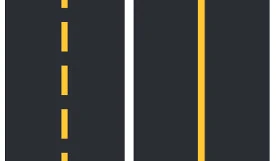 Question: The provincial driving guide, Learn to Drive Smart, in the yellow lines section, cites:
Question: The provincial driving guide, Learn to Drive Smart, in the yellow lines section, cites:
Broken line -- passing is allowed when safe
Single yellow line -- vehicles travelling in either direction may pass when it is safe
What is the difference?
Yellow Lines vs White Lines
Simply put, yellow lines divide lanes of traffic travelling in opposite directions. White lines divide traffic lanes travelling in the same direction.

Both situations really mean the same thing when we are talking about yellow lines. The Motor Vehicle Act says:
Single Yellow Lines
155 (1) Despite anything in this Part, if a highway is marked with
(c) one single line, broken or solid, the driver of a vehicle must drive the vehicle to the right of the line, except only when passing an overtaken vehicle.
(2) Subsection (1) (b) (i) and (c) do not apply if a driver is avoiding an obstruction on the highway and first ascertains that the movement can be made with safety and without affecting the travel of any other vehicle.
I have seen advice on BC driving school websites that suggest a driver who is passing over a single solid yellow line should only do so with extreme caution as sight lines may be restricted. The implication is that areas marked with a single broken yellow line are less likely to have these restrictions.
Suspension of section 155
156 If the driver of a vehicle is causing the vehicle to enter or leave a highway and the driver has ascertained that he or she might do so with safety and does so without unreasonably affecting the travel of another vehicle, the provisions of sections 151 and 155 are suspended with respect to the driver while the vehicle is entering or leaving the highway.
Learn More
Share This Article
I guess the only real difference is the amount of paint needed to mark them!
- Log in to post comments
Here's the difference according to my son's driving instructor.
With the solid yellow line, the driver can safely make a left turn (into a driveway) only when traffic behind is not impeded by such action.
With a broken yellow line, the driver can safely make a left turn regardless of traffic behind.
- Log in to post comments
Solid single lines are typically used on secondary roads. I'd guess they are used when no survey of the road is done to establish safe passing zones - drivers must rely on their own judgement.
For what it's worth, a broken line doesn't always indicate a safe passing zone. A slight rise ahead may not pose a view restriction to the driver of a truck, but it might be a problem for the driver of a car. It's always best to use one's own judgement, and pass based on what you can actually see. I almost learned this the hard way when I was 16 . . .
- Log in to post comments
- Log in to post comments

The Difference